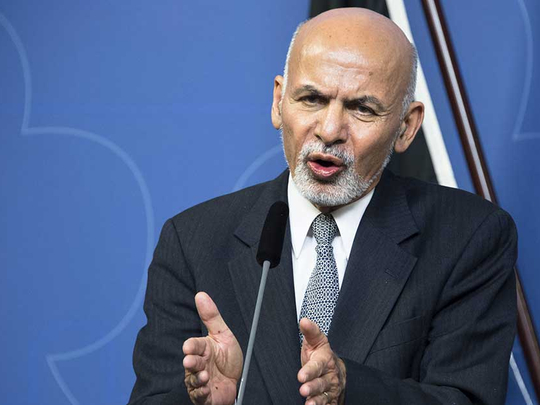
Afghanistan and Pakistan continue to spar over terrorist acts in each other’s country. Pakistan’s military action beginning two years back succeeded in clearing much of the tribal belt of militants. In the absence of similar military action on the other side hundreds escaped to Afghanistan. Common ethnicity and similarity of terrain provides a convenient escape for the fugitives from the other side.
Afghanistan has remained in the state of war within since the Suar Revolution in April 1978 when the People’s Democratic Party of Afghanistan overthrew President Daoud Khan. This coup became the prelude to the Soviet intervention in Afghanistan in 1979.
Afghanistan has a history of being a ‘graveyard of the empires’ and more recently is proving to be one for the US. Despite spending nearly three-quarters of a trillion dollars (Dh3.67 trillion) since 2001 the US is still not sure on how to extricate itself from Afghanistan. The US hopes to control Afghanistan through raising a new US-funded Afghan defence force has misfired. The soldiers retain their loyalty to their tribes instead of allegiance to the national army. The desertion rate is high. The officer corps is top heavy and corrupt.
Large-scale corruption persists in nearly every facet of public service, placing the country just above Somalia and North Korea at the bottom of international rankings. The US-brokered national unity government set up after a deeply contested election result remains dysfunctional.
As the western concepts of democracy are alien to the Afghan society only the beneficiaries of the system support it. The stalemate therefore, continues both on the ground and in the minds of men steeped in historic tribal governance structures.
Notwithstanding American strategic blunders, short of domestic reconciliation or a winner on the ground, which is the Afghan tradition and history, peace will remain elusive unless interests of several countries with competing claims are aligned.
Afghanistan’s most troubled relations are with Pakistan. Opposing Pakistan’s admission into the UN at independence in 1947, for nearly 25 years Afghanistan continued to host Pakistan’s Pashtun nationalists who sought autonomy for Pashtun areas between the Durand Line and Indus River to cut at the very state of Pakistan. Afghanistan therefore, reflects Pakistan’s identity related insecurities due to Afghan non-acceptance of Durand Line as the recognised border. With nearly 40 per cent Pashtuns residing on the Pakistan side, this connection plays a significant part in determining inter-state relations between Kabul and Islamabad.
Pakistan’s fears of growing Indian influence in Afghanistan, which could trap Pakistan in a two-front situation, compels Pakistan to seek a friendly government in Kabul, which Afghans assume is demanding subservience. India’s interests in Afghanistan typically exist in the context of strategic rivalry between India and Pakistan. India’s larger interests in Afghanistan extend beyond Pakistan to its desire for increased trade and energy related relations between India and Central Asia. And when Pakistan due to its strategic rivalry with India, disallows the use of land route both India and Afghanistan get parked in the same tent. India remains wary of a fundamentalist Afghanistan that can provide a breeding source for militants operating in Jammu and Kashmir.
The Iranians view American presence in Afghanistan with unease but is equally concerned at the chance of extremists returning to power in Kabul.
Chinese policies towards Afghanistan are shifting in parallel with its increasing economic interests. A disturbed Afghanistan significantly jeopardises China’s Belt and Road Initiative. Stable Afghanistan-Pakistan relations with influential Pakistan weakens Indian influence and blunts Indian desire of strategic rivalry with China in the region.
The Chinese are wary of strategic encirclement through long-term American presence in Afghanistan. And yet, would be happy to see America bleed while maintaining some order. Russia’s primary threat through Afghanistan relates to its Central Asian neighbourhood. Russia does not want Afghan extremism and instability spill into these states. Russia is also concerned at the flow of drugs into this region and onto its territory. Russia, like China, wants to keep the American influence to the minimum in its neighbourhood.
The US, after 17 years of intervention still seems to be confused at its goals in Afghanistan. From eliminating the Taliban, they have moved to nation-building and then to leave behind a stable but a client Afghanistan. The biggest US folly is to live in its messianic worldview in wanting to create disparate societies in its image.
Peace in Afghanistan is tied to India-Pakistan relations. Islamabad genuinely fears that Afghanistan may well act as India’s proxy against Pakistan. Until Pakistan is secure in its relations with India it will continue to deny India space in Afghanistan. As they both jostle for influence the rift between the two contributes to an unsettled Afghanistan. In the absence of a political settlement no power is likely to succeed in imposing peace in the country. From times of Alexander, the great Moghul Babar, to the British, the Russians and now the Americans no outsider has been able to hold Afghanistan. As American thinker George Santayana said, “those who do not learn from history are doomed to repeat it.”
Sajjad Ashraf is an adjunct professor at the Lee Kuan Yew School of Public Policy, National University of Singapore. He was a member of Pakistan Foreign Service 1973 – 2008 and served as Pakistan’s Consul General in Dubai during the mid 90s.










